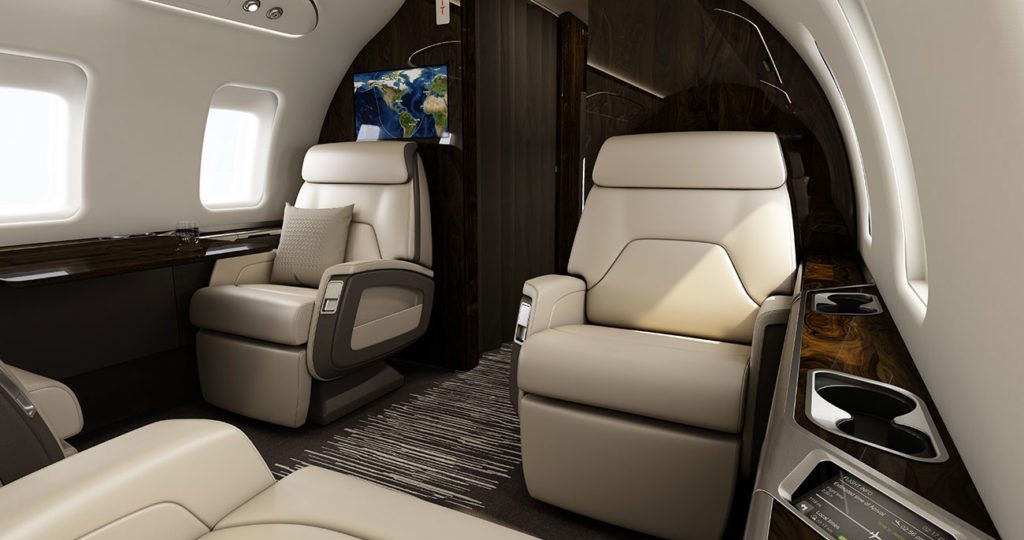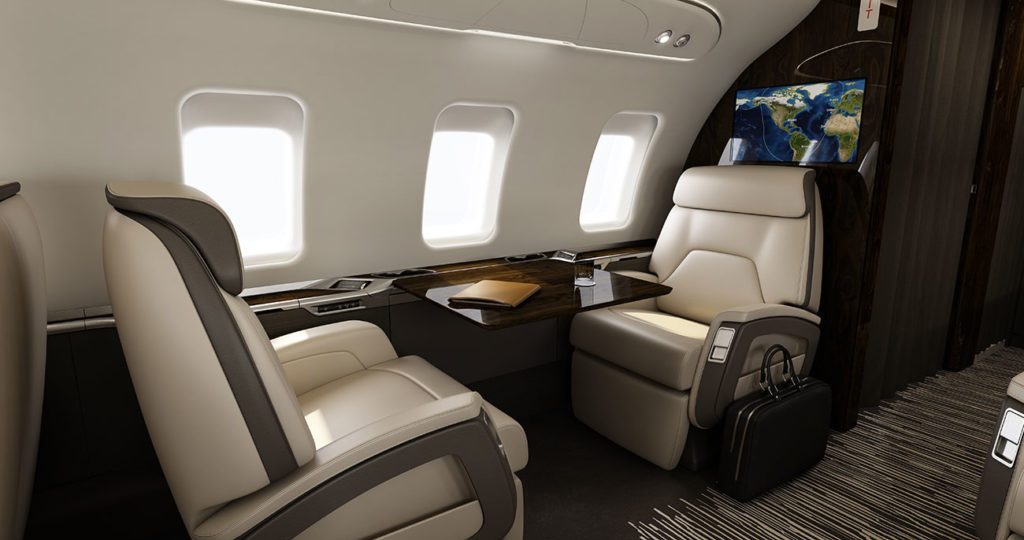The Challenger 650, a big bird with small costs

UNRIVALLED CAPABILITIES
The cockpit is wide and very comfortable and pilots are happy with the flight characteristics of the CL650 but the cabin is where the aircraft shines. You might be tempted to say big, and big is the one word that best describes it, but that would be dismissing that above everything it’s comfortable and well-designed. The cabin is large at 7 feet 11 inches wide and 6 feet high, the same as the Global series, but it’s the seats that dazzled me at 22 inches from arm-rest to arm-rest. They move every way you can think of and even if you play on the tall end of the NBA you’d be hard pressed not to find a position that suits you. This would be the ideal plane for Japanese Sumo wrestlers if girth were more of a concern. I liked the ergonomic side ledges. They were more than comfortable and designed to live with the electronic gadgets we have become addicted to. I felt this interior adapted to me rather than making me adapt to it. There is also a very intuitive app for cabin controls, simple enough for me to use.
The sound system is outstanding and instead of a few speakers thrown haphazardly together producing localised pockets of sound, the cabin is instead lined with 24 transducers producing linear sound through the sidewalks for the entire length of the cabin. There are no bad spots. It’s not quite a concert hall, but it’s not far off either. It’s the best sound system I have ever heard airborne. Best of all, it’s offered as a standard feature and not an option. The cabin is also very well insulated and quiet enough for passengers to whisper when conducting a conversation. There are 2 sources for air conditioning for extra reliability in warm climates. New super fast worldwide Ka-Band internet access is now an option and so is Swift Broadband and air-to-ground high speed internet for use in the continental USA.
The stairs had me at hello with beautiful chrome handrails on both sides. I don’t want to tempt gravity when climbing into an aircraft and I certainly don’t want my passengers to risk life and limb either. I was greeted by a beautiful galley with its signature curve but I absolutely loved the pocket door. I also loved the stone floor. It looks beautiful and it shares applause with the lavatory.
Ultimately though, the question is how does it fly? Here Bombardier outdid themselves and proposed a trip to ferry much-needed supplies to hurricane stricken Puerto Rico and St Barthelemy, in the Caribbean. A humanitarian and relief mission it would be. We loaded up generators, tools, chainsaws and tarps and set off from Teterboro outside New York. Tradewind Aviation again generously offered to ferry the supplies the rest of the way to St Barth.
AIRBORNE
The acceleration is brisk and the latest GE’s CF34 engines pump out some serious power, about five per cent more thrust than their predecessors. Engine overhaul times remain the same despite the increased thrust. There are more than 2000 of these engines in service in the military and they power the A-10 (US Air Force) as well. It’s one of the most reliable military airplanes in the world and not coincidentally also often referred to as a tank. The engines also see service in over 2000 corporate and regional aircraft and have logged over 50,0000 hours on a single engine with 99.99% dispatch reliability. All this translates into low operating costs at about US$340 an hour.
The electrical system is airline-like with AC systems with two generators, an APU generator and a very reassuring air-driven generator that deploys automatically to back up battery power should you be having a very bad day. There are three hydraulic systems and they run on Skydrol, which is less flammable than regular mineral oil used in some other systems.
The avionics are very capable and provide great spatial awareness with four large panels and synthetic vision. It’s also offered at no extra cost. The HUD is very sharp and wide enough so you don’t feel like you are looking through a peephole. The avionics are NextGen-ready and FANS 1/A+ capable, which will provide access to more direct and fuel efficient routes over oceanic and remote areas. ADS-B out V2 is also offered today as a standard feature and will be required for all other operators in 2020. Furthermore, the CL650 is also ADS-C capable with the FANS option. Link 2000+ATN B1 CPDLC is available as well. The CL650 is RNP AR 0.3 capable for shorter approaches and improved access to congested and terrain-challenged airports. I didn’t get a chance to play with the radar in actual conditions but the Multiscan Weather unit is offered at no extra cost and is incredibly capable. It’s the same unit offered in the Global series and on the Boeing 787 Dreamliner. Operating the radar is simplicity itself. It reduces both risk by pointing to clear weather and safe piece of sky and by reducing the need for the advanced skills required to truly properly interpret radar scans. The CL650 is the only aircraft offered with Localizer Performance with Vertical Guidance (LPV) as a standard feature. This system offers the capability for operating to lower minimums and increases the chances of making it to the runway in low visibility days.
I like the increased safety of the SmartRunway and SmartLanding systems with their aural and visual call-outs during the most critical phases of operations. Short final after a long flight is not the time to find out you are approaching the wrong runway at a busy airport. Lest I forget, the Challenger 650 is approved for London City approaches cutting valuable time getting into London. Short of Biggin Hill, the undiscovered and well-managed gem in the area, most London airports are far from the city.
Auto throttles are an STC but are amazing. They are great at leading from descents and don’t hunt for the optimum angle or speed like so many other systems. They are the smoothest units I have ever operated and unlike most other systems, which must be disconnected near the ground, the CL650’s auto throttles can remain engaged all the way to touchdown. This is nice as the most dangerous time to stall is when you are near the ground.
SO HOW DOES IT FLY?
You may be wondering how does the 650 fly? The answer is very well. It was fun to fly with no bad habits to report. The tiller is sharp, the controls are crisp, more Falcon-like than not. The brakes are linear and don’t grab much. V1 and Vr flashed up quickly and we were given the usual Teterboro departure contortions and advanced aerial gymnastics, which the autopilot performed smoothly. Once cleared to higher altitudes we unleashed the beast within the CL650 and pegged the vertical speed indicator to its upper regions. For an aircraft of its size, the Challenger 650 sips fuel and operating one is a sure way not to endear oneself to OPEC nations.
Before the relief flight to the Caribbean, Bombardier arranged for me to fly a few approaches at nearby Stewart, a large joint civilian-military field with a runway long enough to accommodate C-5 military cargo planes. They need not have worried, the CL650 can stop on a dime-2402 feet to be precise-and can easily operate out of short fields. You can fly 1000 nautical miles out of a runway shorter than 3500 feet and 2000 nm out of a strip less than 4000 feet. Depart from pavement shorter than 5000 feet and you can still fly almost 7 hours away. At max range you can ford 4000 nm. From New York you can make it to Anchorage on your way to Tokyo or Beijing or you can aim straight for a good portion of Western Europe or St Petersburg with 6 passengers on board. Once in London you’ll make Nairobi or New Delhi or from San Juan where we landed, Argentina, Western Africa and Southern California were a one non-stop hop away. Some turbulence was reported on our flight but we sliced through it easily and with nary a bump. The CL650 has a high wing loading so bumps, which would normally worry some passengers, can be flown through while sipping champagne from full glasses. The approach angle which gave my friends-who have never flown a Challenger 650 much anxiety, is different than most other planes but no big deal if you know what to expect. Point the nose down and don’t flare too much. That’s it.
LOW MAINTENANCE & DIRECT OPERATING COSTS
The passengers could have continued to drink all the way to touchdown as the trailing link landing gear made me look good. The CL650 has one more trick up its sleeve and it explains why high-usage operators have been using Challengers for years: maintenance. Low hourly costs and fewer maintenance events are important. Visits to the shop are scheduled every 600 hours or 24 months for A inspections, and 8 years for C inspections. Most other aircraft have to visit the shop every 400 to 500 hours, and most C inspections are due every 6 years. Direct operating costs are a low US$2,474 an hour at Mach .80 and $5 a gallon on standard average 600 nm missions but most operators can buy fuel at much lower prices, thus lowering operation costs even further. This amount even includes average landing fees, etc, … Operating a CL650 will cost about $600,000 per year, less than most competitors similar offerings.
The verdict: the Challenger 650 is a very solid plane.








